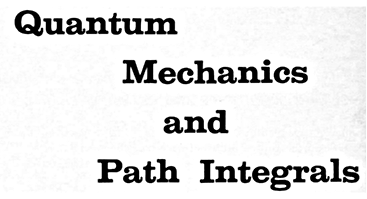
\(\)
Problem 6-6
Suppose the potential is that of a central force. Thus \(V(\mathbf{r})=V(r)\). Show that \(v(\mathbf{q})\) can be written as
\begin{equation}
\def\mb#1{\mathbf{#1}}
v(\mb{q})=v(q)=\frac{4\pi\hbar}{q}\int_0^{\infty} r\sin\left(\frac{q r}{\hbar}\right)\,V(r)\,dr
\tag{6-45}
\end{equation}
\def\mb#1{\mathbf{#1}}
v(\mb{q})=v(q)=\frac{4\pi\hbar}{q}\int_0^{\infty} r\sin\left(\frac{q r}{\hbar}\right)\,V(r)\,dr
\tag{6-45}
\end{equation}
Suppose \(V(r)\) is the Coulomb potential \(V(r)=-Ze^{2}/r\).In this case the integral for \(v(q)\) is oscillatory at the upper limit. But convergence of the integral can be artificially forced by introducing the factor \(e^{-\varepsilon r}\) and then taking the limit of the result as \(\varepsilon\to 0\). Following through this calculation, show that the cross section corresponds to the Rutherford cross section
\begin{equation}
\def\ds#1{\mbox{${\displaystyle\strut #1}$}}
\frac{d \sigma(\theta)}{d \Omega}\Bigg|_{Ruth} =\frac{4Z^{2}e^{4}m^{2}}{q^{4}}=\frac{Z^{2}e^{4}}{16\left(\ds{\frac{mu^{2}}{2}}\right)^{2}\sin^{4}\left(\ds{\frac{\theta}{2}}\right)}
\tag{6-46}
\end{equation}
\def\ds#1{\mbox{${\displaystyle\strut #1}$}}
\frac{d \sigma(\theta)}{d \Omega}\Bigg|_{Ruth} =\frac{4Z^{2}e^{4}m^{2}}{q^{4}}=\frac{Z^{2}e^{4}}{16\left(\ds{\frac{mu^{2}}{2}}\right)^{2}\sin^{4}\left(\ds{\frac{\theta}{2}}\right)}
\tag{6-46}
\end{equation}
\begin{align}
\def\mr#1{\mathrm{#1}}
\mr{where}\quad e&= \mr{charge}\ \mr{on}\ \mr{an}\ \mr{electron}\\
q&=2p\sin \left(\frac{\theta}{2}\right)=2mu\sin \left(\frac{\theta}{2}\right) \tag{6-47}\\
\theta&= \mr{angle}\ \mr{between}\ \mr{the}\ \mr{vectors}\ \mb{i}_a\ \mr{and}\ \mb{i}_b
\end{align}
\def\mr#1{\mathrm{#1}}
\mr{where}\quad e&= \mr{charge}\ \mr{on}\ \mr{an}\ \mr{electron}\\
q&=2p\sin \left(\frac{\theta}{2}\right)=2mu\sin \left(\frac{\theta}{2}\right) \tag{6-47}\\
\theta&= \mr{angle}\ \mr{between}\ \mr{the}\ \mr{vectors}\ \mb{i}_a\ \mr{and}\ \mb{i}_b
\end{align}
( 解答 ) \(v(\mb{q})\) の定義は式 (6-39) で与えれていた:
\begin{equation}
v(\mb{q})=\int d^{3}\mb{r}\,e^{i\mb{q}\cdot\mb{r}/\hbar}\,V(\mb{r})
=\int d^{3}\mb{r}\,e^{i(\mb{p}_a-\mb{p}_b)\cdot\mb{r}/\hbar}\,V(\mb{r})
\tag{1}
\end{equation}
v(\mb{q})=\int d^{3}\mb{r}\,e^{i\mb{q}\cdot\mb{r}/\hbar}\,V(\mb{r})
=\int d^{3}\mb{r}\,e^{i(\mb{p}_a-\mb{p}_b)\cdot\mb{r}/\hbar}\,V(\mb{r})
\tag{1}
\end{equation}
\(\mb{q}\) の方向を \(z\)-軸とする極座標系を採用すると, 体積要素は次となる:
\begin{equation}
d^{3}\mb{r}=r^{2}dr\sin\theta d\theta d\phi
\end{equation}
d^{3}\mb{r}=r^{2}dr\sin\theta d\theta d\phi
\end{equation}
よって, 式 (1) は次のように表される:
\begin{align}
v(\mb{q})&=\int_0^{2\pi}d\phi \int_0^{\infty}r^{2}\,dr\int_0^{\pi}d\theta\,\sin\theta\,
e^{iqr\cos\theta/\hbar}\,V(r)\\
&=2\pi\int_0^{\infty}V(r)\,r^{2}\,dr\int_0^{\pi}d\theta\,\sin\theta\,e^{iqr\cos\theta/\hbar}
\tag{2}
\end{align}
v(\mb{q})&=\int_0^{2\pi}d\phi \int_0^{\infty}r^{2}\,dr\int_0^{\pi}d\theta\,\sin\theta\,
e^{iqr\cos\theta/\hbar}\,V(r)\\
&=2\pi\int_0^{\infty}V(r)\,r^{2}\,dr\int_0^{\pi}d\theta\,\sin\theta\,e^{iqr\cos\theta/\hbar}
\tag{2}
\end{align}
ここで \(\cos\theta=t\) と変数変換するならば, \(dt=-d\theta \sin\theta\) で積分範囲は \([1,-1]\) となるから,
\begin{align}
&\int_0^{\pi}d\theta\,\sin\theta\,e^{i q r\cos\theta/\hbar}=\int_{1}^{-1}(-dt)e^{i q r t/\hbar}\\
&=\int_{-1}^{1}dt\,\cos\left(\frac{q r t}{\hbar}\right)+i\int_{-1}^{1}dt\,\sin\left(\frac{q r t}{\hbar}\right)\\
&=\frac{\hbar}{q r}\left[\sin\left(\frac{q r}{\hbar}t\right)\right]_{-1}^{1}
=\frac{2\hbar}{q r}\sin\left(\frac{q}{\hbar}r\right)
\tag{3}
\end{align}
&\int_0^{\pi}d\theta\,\sin\theta\,e^{i q r\cos\theta/\hbar}=\int_{1}^{-1}(-dt)e^{i q r t/\hbar}\\
&=\int_{-1}^{1}dt\,\cos\left(\frac{q r t}{\hbar}\right)+i\int_{-1}^{1}dt\,\sin\left(\frac{q r t}{\hbar}\right)\\
&=\frac{\hbar}{q r}\left[\sin\left(\frac{q r}{\hbar}t\right)\right]_{-1}^{1}
=\frac{2\hbar}{q r}\sin\left(\frac{q}{\hbar}r\right)
\tag{3}
\end{align}
ただし虚数部の積分は, 被積分関数が奇関数であるからゼロとなることに注意する.従って,
\begin{align}
v(\mb{q})&=2\pi\times\int_0^{\infty}dr\,r^{2}\,V(r)\times\frac{2\hbar}{q r}\sin\left(\frac{q}{\hbar}r\right)\\
&=\frac{4\pi\hbar}{q}\int_0^{\infty}r\,\sin\left(\frac{q}{\hbar}r\right)\,V(r)\,dr
\tag{4}
\end{align}
v(\mb{q})&=2\pi\times\int_0^{\infty}dr\,r^{2}\,V(r)\times\frac{2\hbar}{q r}\sin\left(\frac{q}{\hbar}r\right)\\
&=\frac{4\pi\hbar}{q}\int_0^{\infty}r\,\sin\left(\frac{q}{\hbar}r\right)\,V(r)\,dr
\tag{4}
\end{align}
「単位立体角当たりの断面積 \(I=d\sigma/d\Omega\)」の表現式 (6-44) に, 上の結果と, 題意による因子 \(e^{-\varepsilon r}\) を挿入して \(\varepsilon\to 0\) の極限をとるならば,
\begin{align}
I&=\left(\frac{m}{2\pi\hbar^{2}}\right)^{2}\bigl|v(\mb{q})\bigr|^{2}\\
&=\lim_{\varepsilon\to 0}\left(\frac{m}{2\pi\hbar^{2}}\right)^{2}\left|\frac{4\pi\hbar}{q}
\int_0^{\infty}dr\,r\,e^{-\varepsilon r}\sin\left(\frac{q}{\hbar}r\right)\,V(r)\,\right|^{2}\\
&=\frac{4 m^{2}}{\hbar^{2}q^{2}}\lim_{\varepsilon\to 0}\left|\int_0^{\infty}e^{-\varepsilon r}\sin
\left(\frac{q}{\hbar}r\right)\frac{-Z e^{2}}{r}\,r\,dr\,\right|^{2}\\
&=\frac{4 Z^{2} e^{4 }m^{2}}{\hbar^{2}q^{2}} \lim_{\varepsilon\to 0}\left|\int_0^{\infty}e^{-\varepsilon r}
\sin\left(\frac{q}{\hbar}r\right)\,dr\,\right|^{2}
\tag{5}
\end{align}
I&=\left(\frac{m}{2\pi\hbar^{2}}\right)^{2}\bigl|v(\mb{q})\bigr|^{2}\\
&=\lim_{\varepsilon\to 0}\left(\frac{m}{2\pi\hbar^{2}}\right)^{2}\left|\frac{4\pi\hbar}{q}
\int_0^{\infty}dr\,r\,e^{-\varepsilon r}\sin\left(\frac{q}{\hbar}r\right)\,V(r)\,\right|^{2}\\
&=\frac{4 m^{2}}{\hbar^{2}q^{2}}\lim_{\varepsilon\to 0}\left|\int_0^{\infty}e^{-\varepsilon r}\sin
\left(\frac{q}{\hbar}r\right)\frac{-Z e^{2}}{r}\,r\,dr\,\right|^{2}\\
&=\frac{4 Z^{2} e^{4 }m^{2}}{\hbar^{2}q^{2}} \lim_{\varepsilon\to 0}\left|\int_0^{\infty}e^{-\varepsilon r}
\sin\left(\frac{q}{\hbar}r\right)\,dr\,\right|^{2}
\tag{5}
\end{align}
このときの絶対値中の積分は, \(\varepsilon\to 0\) の極限では \(e^{-\varepsilon r}\to 0\) であることから,
\begin{align}
&\int_0^{\infty}e^{-\varepsilon r}\sin\left(\frac{q}{\hbar}r\right)\,dr\\
&=\left[\frac{-\hbar}{q}\cos\left(\frac{q}{\hbar}r\right)\,e^{-\varepsilon r}\right]_0^{\infty}
-\varepsilon\frac{\hbar}{q}\int_0^{\infty}\cos\left(\frac{q}{r}r\right) e^{-\varepsilon r}\,dr\\
&=0-\frac{-\hbar}{q}=\frac{\hbar}{q},\quad \left(\,\varepsilon\to 0\,\right)
\tag{6}
\end{align}
&\int_0^{\infty}e^{-\varepsilon r}\sin\left(\frac{q}{\hbar}r\right)\,dr\\
&=\left[\frac{-\hbar}{q}\cos\left(\frac{q}{\hbar}r\right)\,e^{-\varepsilon r}\right]_0^{\infty}
-\varepsilon\frac{\hbar}{q}\int_0^{\infty}\cos\left(\frac{q}{r}r\right) e^{-\varepsilon r}\,dr\\
&=0-\frac{-\hbar}{q}=\frac{\hbar}{q},\quad \left(\,\varepsilon\to 0\,\right)
\tag{6}
\end{align}
この結果式 (6) と \(q=2mu\sin(\theta/2)\) を式 (5) に代入するならば, 求めるべき「Rutherford 散乱の断面積」の式 (6-46) が得られる:
\begin{align}
I&=\frac{4Z^{2}e^{4} m^{2}}{\hbar^{2}q^{2}}\times\left|\frac{\hbar}{q}\right|^{2}=\frac{4Z^{2}e^{4}m^{2}}{q^{4}}
=\frac{4Z^{2}e^{4}m^{2}}{\ds{\left[2m u\sin\left(\frac{\theta}{2}\right)\right]^{2}}}\\
&=\frac{Z^{2}e^{4}}{\ds{16\left(\frac{m u^{2}}{2}\right)^{2}\sin^{4}\left(\frac{\theta}{2}\right)}}
\tag{7}
\end{align}
I&=\frac{4Z^{2}e^{4} m^{2}}{\hbar^{2}q^{2}}\times\left|\frac{\hbar}{q}\right|^{2}=\frac{4Z^{2}e^{4}m^{2}}{q^{4}}
=\frac{4Z^{2}e^{4}m^{2}}{\ds{\left[2m u\sin\left(\frac{\theta}{2}\right)\right]^{2}}}\\
&=\frac{Z^{2}e^{4}}{\ds{16\left(\frac{m u^{2}}{2}\right)^{2}\sin^{4}\left(\frac{\theta}{2}\right)}}
\tag{7}
\end{align}
